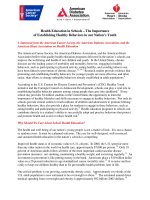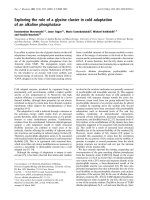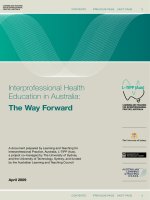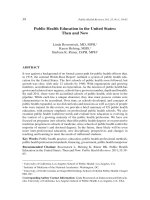Health education in prisons: assessment of an experience with diabetics doc
Bạn đang xem bản rút gọn của tài liệu. Xem và tải ngay bản đầy đủ của tài liệu tại đây (89.28 KB, 7 trang )
Rev Esp Sanid Penit 2009; 11: 73-79
A Minchón Hernando, JA Domínguez Zamorano, Y Gil Delgado.
Health education in prisons: assessment of an experience with diabetics
— 73 —
Health education in prisons: assessment of an
experience with diabetics
A Minchón Hernando
1
, JA Domínguez Zamorano
2
, Y Gil Delgado
3
1
Director de Enfermería del Hospital Infanta Elena (Huelva)
2
Supervisor de Enfermería del Centro Penitenciario de Huelva
3
Técnico Superior en Nutrición y Dietética
ABSTRACT:
Background: A training strategy designed at Huelva Prison sets out to provide diabetic inmates with training and basic
information about the illness.
Method: Descriptive and cross-sectional study carried out at Huelva Prison. Information was acquired using question-
naires prepared for the study. A descriptive analysis was then made using averages for quantitative variables and absolute and
relative frequencies for the quantitative variables.
Results: 27 interviewed diabetics (24 men and 3 women), participation rate, 69.2 %, response rate 84.4%, average age
48.3 CI 95% (43.7 to 52.9). 66.7% insulin dependent and 33.3% receiving oral anti-diabetic treatment. Hit rate in questions
assessing knowledge was over 80%.
Conclusions: The study derives from the need to increase awareness of inmates’ difficulties in adapting standard diets
to the nutritional requirements imposed by the illness. Short term results such as these cannot be used to assess changes of
attitude, although one notable conclusion that can be drawn is the high level of participation and interest by inmates and the
consequent possibility of setting up self-help groups.
Key words:
Health Education; Prisons; Diabetes Mellitus; Feeding; Nutrition, Public Health; Spain; Prisoners; Health
Promotion.
Text received: March 2009 Text accepted: June 2009
Rev Esp Sanid Penit 2009; 11: 73-79
A Minchón Hernando, JA Domínguez Zamorano, Y Gil Delgado.
Health education in prisons: assessment of an experience with diabetics
— 74 —
INTRODUCTION
The specific features that depict the penitentiary
environment involve using new strategies basically
directed at health promotion and disease prevention.
Amongst such features some can be outlined such as
the high prevalence of pathologies, a low social, eco-
nomic and cultural profile, as well as difficult access
to health services. Some studies indicate that social
inequality can be responsible of increases in the pre-
valence of some diseases such as DM2 while, on the
other hand, the provision and quality of primary care
services can play a major role in reducing the conse-
quences of such inequality.
Health education amongst inmates is considered
as a major objective among both nursing professionals
from the Prison of Huelva, acting as a primary care
centre, and their reference Hospital: Hospital Infan-
ta Elena. Within this cooperation environment, for
the last two years a program specifically directed at
inmates has been taking place, and now, because of
the aforementioned features, is particularly aimed at
diabetics. Diet and diet therapy monitoring and con-
trol conditions within prisons in general and towards
diabetic patients in particular, make us consider food
education for this risk population as a major tool for
glycemic control.
We initially know that Food and Nutrition Edu-
cation, within human nutrition, is a key tool in pre-
venting, promoting and treating nutrition disorders
and chronic diseases.
Diabetes mellitus is, because of the number of
people affected and the cost related to the disease
and its complications (it is one of the main causes of
mortality in Spain) a pathology that requires from the
patients a specific education on the problem and its
treatment.
The main objectives we are taking into considera-
tion for these education sessions are the following:
• Knowing the basis of a healthy diet.
• Developing healthy habits and correcting the
bad ones.
• Identifying carbohydrates and knowing how
frequently they should be consumed.
• Understanding how important and healthy
water is for a diabetic patient in contrast with
least healthy beverages.
• Promoting physical exercise as a healthy lifes
-
tyle for a diabetic patient.
• Preventing and reducing possible glycemia di
-
sorders.
• Knowing the benefits derived from a healthy
diet.
• Preventing risk factors such as high blood cho
-
lesterol, hyperglycemia, high blood pressure,
obesity, etc. through nutrition.
At the end of the sessions we decided to gather
information through a series of questionnaires that
allowed us to assess both the process of education
intervention and the results derived from it, discer-
ning:
• Basic principles on nutrition
✓ Information on nutrients
✓ Diet plan for the control of diabetes
✓ Recommendations: daily meals distribution
• Healthy diet plan for a diabetic patient
✓ Eliminating unhealthy food
✓ Alternatives within the Penitentiary Facility
✓ Including all food groups
Controlling food rich in carbohydrates
• The importance of water
✓ An appropriate hydration with meals
✓ Choice beverages in diabetes
✓ The importance with physical exercise
✓ Other healthier substitutes
•
Physical activity and its importance for diabetic
patients
✓ Adapted physical activity and its importance
for diabetic patients
✓ Advantages
✓ Using appropriate shoes
✓ Foreseeing possible hypoglycemia
✓ Diet- exercise- treatment as the basic pillar
•
Advantages of an appropriate diet for a diabetic
patient
✓ Glycemia adjustment
✓ Appropriate adjustment of treatment dosage
✓ Important role of fiber in eliminating glucose
✓ Preventing diseases related to diabetes
TEXT BOX NUMBER 1: THE CONTENTS OF THE SESSIONS ARE SPECIFIED
Rev Esp Sanid Penit 2009; 11: 73-79
A Minchón Hernando, JA Domínguez Zamorano, Y Gil Delgado.
Health education in prisons: assessment of an experience with diabetics
— 75 —
1. The inmates’ assessment on the session. Seve-
ral questions on the methodology used were
made.
2. Efficiency or learning level acquired during the
session.
3. Efficiency or implication level on future activi
-
ties related to food control or menu modifica-
tions for diabetic patients.
MATERIAL AND METHODS
Design: descriptive and transversal study carried
on the Correctional Facility of Huelva.
The selection process among inmates was made
by the prison itself within the Diabetes Control Pro-
gram which was set up during 2008.The selection of
the sample was made among all inmates within the
Correctional Facility with diabetes mellitus who vo-
luntarily wanted to participate in the study.
This program intends to confer autonomous con-
trol to the patients both within the facility and after
their release and is based on the strategic guidelines
established by the Diabetes Comprehensive Plan of
Andalucía.
Thirty-nine inmates with diabetes types I and II
were selected and they assisted two hour long theory
tuitions in groups of under 15 inmates, fulfilling three
sessions altogether, in which active participation pla-
yed a major role in solving any doubts.
The speeches were adapted to the normal routine
of the facility so that this was not disrupted.
Contents of the training sessions
7-14
:
• Main nutrition principles.
• Healthy diet plan for a diabetic patient.
• The importance of water.
• Physical activity and its importance for diabetic
patients.
• Recommendations to prevent complications.
• Benefits of a balanced diet for diabetic pa
-
tients.
The contents of the sessions are specified in text
box number 1.
Gathered information: information was collec-
ted by means of specifically designed questionnaires,
after each session.
Statistic analysis: it was descriptive and used
average results for quantitative variables and absolute
and relative frequencies for qualitative variables, the
confidence interval being 95%.
The analysis of the data was made with the statis-
tic software SPSS v. 112.
Ethic and legal issues:
authorization for carrying
out this study was requested to the Support Unit of
the Directorate General of Correctional Facilities, in
accordance to Orden Circular 7/99 sobre “Trabajos,
estudios e investigaciones en el medio penitencia-
rio”
15
.
(Notification Order 7/99 on “Reports, studies
and research within the correctional environment”).
All patients were requested written informed
consent, in accordance to current legal regulation and
particularly to Organic Act 15/1999 of 13 December,
regarding Personal Information Protection
16
as well
as Sections 4.2.b; 211.2 and 211.3 of the current Peni-
tentiary Regulation
17
.
RESULTS
The total number of those polled (27) was less
than the number of assistants (32, out of 39 diabe-
tic patients), the participation rate therefore being
69.2% and the response rate, 84.4%, bearing in mind
that some inmates had to abandon the study due to
different reasons. Recruiting them afterwards for the
study would have meant misrepresenting the results
as a result of the inmates not counting with all the
necessary information. Nobody refused to partici-
pate.
24 men (88.9%) and 3 women (11.1%) filled in
the questionnaires, the average age being 48.3 years
and the CI, 95% (43.7 to 52.9). The median age was
46.5 years and a range between 32.1 years and 77.5
years.
With regard to diabetic patients, 18 (66.7%) un-
derwent insulin treatment and 9 (33.3%), took oral
anti-insulin drugs.
As far as the nationality is concerned, two people
among those polled were foreigners. According to
their origin, for 5 inmates (18.5), this was their first
time in prison, for the rest, 22, (81.5%) were already
in prison or came from other facilities.
Rev Esp Sanid Penit 2009; 11: 73-79
A Minchón Hernando, JA Domínguez Zamorano, Y Gil Delgado.
Health education in prisons: assessment of an experience with diabetics
— 76 —
What type of food should be removed from
a diabetic diet?
Ice cream, cakes and sweets
22 (81.48%)
Fruit, dairy products and cereal
5 (18.52%)
What can you drink instead of regular coke?
Diet coke or coke Zero
25 (92.59%)
Wine
2 (7.41%)
Is sugar recommended with coffee?
Yes
0 (0.00%)
No, but sweeteners can be used instead
27 (100%)
How many meals are daily recommended?
3 meals per day
2 (7.41%)
5 or 6 meals per day
25 (92.59%)
Is breakfast necessary for a diabetic patient?
Yes, always
27 (100%)
No
0 (0.00%)
Which of the following are recommended
for a diabetic breakfast?
Fruit, dairy products and
cereal
27 (100%)
Milk and something sweet
0 (0.00%)
How many pieces of fruit are recommended
per day?
1 piece
2 (7.41%)
3 pieces
25 (92.59%)
How many pieces of vegetables are
recommended per day?
1 piece
2 (7.41%)
2 pieces
25 (92.59%)
Which of the following are quickly
absorbed? (occasional consumption)
Fruits
14 (51.85%)
Confectionery, sugar and sweets
13 (48.15%)
Which of the following are slowly
absorbed? (daily consumption)
Cereal
26 (96.3%)
Cakes
1 (3.7%)
What is the best beverage for a diabetic
patient?
Soft drinks
0 (0.00%)
Water
27 (100%)
Can all diabetic patients do physical
activity?
Yes
27 (100%)
No
0 (0.00%)
Are there any key principles for diabetic
patients?
No
2 (7.41%)
Diet-exercise-medical treatment (or insulin)
25 (92.59%)
Are carbohydrates recommended before
doing sport?
Yes
23 (85.19%)
No
4 (14.81%)
If a diabetic patient has taken too much
insulin, what should be done?
There is nothing wrong, it is
not so serious
2 (7.41%)
Increasing flour products, fruit or milk
25 (92.59%)
Do you believe future complications can be
derived from an inadequate diet?
Yes
26 (96.3%)
No
1 (3.7%)
Dou you think there is appropriate food for
a diabetic patient in your module’s store?
Yes
3 (11.11%)
No
24 (88.89%)
Did you know what an appropriate diet was
before this presentation?
Yes
17 (62.96%)
No
10 (37.04%)
Tabla 1: Grado de aprendizaje obtenido tras la charla.
FALTA TRADUCCIÓN
Rev Esp Sanid Penit 2009; 11: 73-79
A Minchón Hernando, JA Domínguez Zamorano, Y Gil Delgado.
Health education in prisons: assessment of an experience with diabetics
— 77 —
Table 1 shows the information on learning levels
gathered with questionnaires. Information on the in-
mates’ assessment about the presentation is depicted
in Table 2, and the information on implication is in-
cluded in Table 3.
The results which are worth underlining are the
high degree of learning achieved after the sessions, so
that there is only one question in which the success
rate is jeopardized with 51.85% (on the question re-
garding quick absorption food). 88.88% of questions
which intended to assess the knowledge achieved were
successfully answered by over 80% of the audience.
It is also worth highlighting the positive assess-
ment of inmates on the session, about which they only
penalized its duration, with 51.85% of them finding
it was not too short. This makes us consider future
modifications on the sessions, where other audiovi-
sual features could be included to liven up the pre-
sentations, considering that all the audience (100%)
agreed on the way the sessions took place and their
convenience.
As far as efficiency is considered, it is also worth
considering the high implication rates among inmates
for future activities; initially over 95% of them agreed
in doing so. We would also like to highlight the ques-
tion related to the convenience of the diabetic diet
within the Facility, which was negatively answered by
81.48% of inmates, in contrast with 96.3% of inmates
who thought that it could be better adjusted to the
needs derived from their disease.
DISCUSSION
Speeches and workshops, which specifically target
reduced groups of marginalized population or with
Yes No
Have you learnt something interesting with this speech?
27 (100%) 0 (0.00%)
Do you think that your control on the disease can be improved after this speech?
27 (100%) 0 (0.00%)
Do you think the speech has been too short?
14 (51.85%) 13 (48.15%)
Have you liked the way the speech has been given?
27 (100%) 0 (0.00%)
Table 2: Inmates’ assessment on the speech.
Yes No
Do you think you know enough about diabetes? 10 (37.04%) 17 (62.96%)
Do you think that you are now going to apply the knowledge achieved in this
speech?
26 (96.3%) 1 (3.7%)
Would you like to attend any more speeches alike? 27 (100%) 0 (0.00%)
Do you think that you would improve your control on the disease if you knew
more on diabetic nutrition?
27 (100%) 0 (0.00%)
Would you agree on attending periodic speeches on nutrition? 26 (96.3%) 1 (3.7%)
Would you agree on attending a nutrition consultation frequently so that they
could teach you the food that you must eat and therefore your disease could
improve?
26 (96.3%) 1 (3.7%)
Do you think this facility’s diabetic diet is appropriate? 5 (18.52%) 22 (81.48%)
Do you think the diabetic diet could be better adjusted? 26 (96.3%) 1 (3.7%)
Table 3: Implication in future activities related to diet control or diabetic menu modifications.
Rev Esp Sanid Penit 2009; 11: 73-79
A Minchón Hernando, JA Domínguez Zamorano, Y Gil Delgado.
Health education in prisons: assessment of an experience with diabetics
— 78 —
low levels of knowledge, regarding issues of special
importance such as their health, is a helpful means of
relevant teaching so that they can better control their
disease. Studies by Cerrillo
18, 19
and Núñez
20
, on the
efficiency of group education on diabetes discuss the
validity of advance practice models in current nur-
sing. This practice is guided towards structured and
planned interventions in accordance with a logic se-
quence and common to all the professionals implied.
Within our assistance context it seems that group ac-
tivities are, in contrast with individual activities, more
efficient and effective and therefore, as Duro Mar-
tínez
21
states, they create more satisfaction amongst
professionals.
Surveys have proved that we have achieved the
objectives of improving the patients’ knowledge on
the management of the disease and therefore reducing
the characteristic complications of this pathology.
The correct management of diabetes entails
knowledge on the appropriate diet that these patients
must have and in most cases these patients don’t have
such knowledge.
It is quite representative the absence of studies
regarding nutrition education for diabetic patients
in prison, considering the key relationship between
an appropriate diet and the management of diabetes;
specially if we consider marginalized groups with oc-
casional external health monitoring.
It would have been more representative to take a
control group to take the survey but, because of the
small number of diabetic patients that we can find
within a facility (39 in our case) and the difficulty
of repeating coordinated activities of this type in the
future, the idea was discarded.
We also considered doing the survey before and
after the speech so that we could better assess the re-
sults, but this implied extending the duration of each of
the sessions and the resulting weariness. On the other
hand it could have implied a reduction in the number
of patients polled because, as the results show, between
the 3 two hour long sessions, 5 inmates abandoned the
speeches because of different regime related causes.
We are aware of the limited sample which so-
mewhat distorts the results, but we must underline
that all the diabetic patients were chosen for the spee-
ches although some of them could not attend them or
had to leave because of regime related causes which
escape our control. On the other hand attention must
be drawn to the fact that surveys were done by all the
inmates who finished the speeches and no one refused
participating.
Other limitations: Amongst opposing or mis-
taken results we have to consider an inmate with se-
vere hypoacusia who admitted not having heard most
of the sessions, some inmates with concentration di-
fficulties who fell into incorrectly filling in the survey
after almost two hours of explications, or the presen-
ce of inmates with oral treatment who incorrectly
answered the question on what to do after taking too
much insulin due to unawareness of the issue. One
inmate proved to be uncommitted with his disease
and has stated to be unconcerned with correcting his
habits (although he admits them) and in future sessio-
ns would supposedly not be susceptible to working
with the rest of the group.
Amongst our future objectives we would like to
repeat the survey in three months, extending our ex-
perience in time and even intervening in the design of
diabetic menus for the concerned inmates so that their
specific needs could be met, regarding both its making
and daily calorie distribution.
Because of the results achieved, the acceptance of
these sessions by both inmates and speakers, and the
experience obtained, we can consider new activities
and the development of more ambitious interven-
tion programs that improve our patients’ health and
quality of life; the creation of an educator network
between professional of both facilities and promoting
the integration of inmates in the role of educators and
counselors within health programs.
CORRESPONDENCE
José Antonio Domínguez Zamorano
Centro Penitenciario de Huelva
Ctra. La Ribera, s/n.
21610 Huelva.
E-mail:
BIBLIOGRAPHY
1. Ruiz-Ramos M, Escolar-Pujolar A, Mayoral-Sán
-
chez E, Corral-San Laureano F, Fernández-Fer-
nández I. La diabetes mellitus en España: mortali-
dad, prevalencia, incidencia, costes económicos y
desigualdades. Gac Sanit 2006; 20 Supl 1: 15-24
2. Minchón Hernando A, Domínguez Zamorano
JA. Aportación de enfermería al proceso de Edu-
cación para la Salud en Instituciones Penitencia-
rias. Documentos de Enfermería 2008; 29: 18-20.
3. Fuillerat Alfonso R. Psicología y nutrición en el
desarrollo ontogenético en la edad infanto-juve-
nil. Nutr. Hosp. [revista en internet]. 2004 Jul.
[citado el 02 de noviembre de 2008]; 19(4): 209-
Rev Esp Sanid Penit 2009; 11: 73-79
A Minchón Hernando, JA Domínguez Zamorano, Y Gil Delgado.
Health education in prisons: assessment of an experience with diabetics
— 79 —
224. Disponible en: />php?script=sci_arttext&pid=S0212-16112004000
400003&lng=es.
4. España 2006. Mortalidad por Causa, Sexo y Gru-
po de edad (CIE 10). Tasa por 100.000 h y Mor-
talidad proporcional. Disponible en: http://www.
sciii.es/htdocs/centros/epidemiologia/anexos/
ww01_ed.htm
5. Selli Lucilda, Papaléo Ledi Kauffmann, Meneghel
Stela Nazareth, Torneros Julián Zapico. Técnicas
educacionales en el tratamiento de la diabetes.
Cad. Saúde Pública [revista en internet]. 2005 Oct.
[citado el 02 de noviembre de 2008]; 21(5): 1366-
1372. Disponible en:
php?script=sci_arttext&pid=S0102-311X2005
000500008&lng=en.
6. Plan Integral de Diabetes de Andalucía: 2003-
2007. 10ª ed. Sevilla: Consejería de Salud, 2003
7. Mataix Verdú, J. Tabla de Composición de Alimen-
tos. 4ª ed. Granada: Universidad de Granada; 2003.
8. Asociación de Enfermería. Educación para la Sa-
lud: Alimentación y Nutrición. Valencia: La Sire-
na; 2005.
9. Figuerola D. Alimentación y Diabetes. Barcelona:
De Masson; 2003.
10. Larrañaga Coll IJ, Carballo Fernández M, Rodrí-
guez Torres MM, Fernández Sainz JA. Dietética
y Dietoterapia. 1ª ed. Madrid. McGraw- Hill/In-
teramericana de España S.A; 1997.
11. Junta de Andalucía; Consejería de Salud. Plan
para la Promoción de Actividad Física y la Ali-
mentación Equilibrada, 2004-2008. Sevilla; 2004.
12. Anguita C, Caixás A, Clapés J, Claveria M, Ga-
llach I, Jansà M, et al. Documento de Consenso
sobre Recomendaciones Nutricionales y de Edu-
cación Alimentaria en la Diabetes. 1ª ed. Barcelo-
na: Asociaciò Catalana de Diabetis; 2003.
13. Jansá M, Vidal M, Gomis R, Esmatjes E. La dia-
betes. Barcelona: Forunclinic/ Fundación BBVA.
Hospital Clinic de Barcelona; 2006.
14. Controlar la Diabetes. Comer Sano con la Funda-
ción Grande Covián y las Recetas de Karlos Ar-
guiñano. 1ª ed. Bilbao: Bainet Media S.A.; 2007.
15. Trabajo, estudios e investigaciones en el medio
penitenciario. Dirección General de Instituciones
Penitenciarias. Circular C 07/99 IP de 8 de julio.
[citado el 02 de noviembre de 2008] Disponible
en:
Archivos/c-1999-07.pdf
16. LEY ORGÁNICA 15/1999, de 13 de diciem-
bre, de Protección de Datos de Carácter Personal
(B.O.E. de 14-12-99)
17. REAL DECRETO 190/1996, de 9 de febrero,
por el que se aprueba el Reglamento penitenciario
(B.O.E. de 15-02-96)
18. Cerrillo Patiño J. La educación grupal a pacientes
diabéticos tipo 2 mejora los conocimientos de la
enfermedad, el control metabólico y factores de
riesgo cardiovascular [Dalmau Llorca MR, García
Bernal G, Aguilar Martín C y Palau Galindo A.
Educación grupal frente a individual en pacientes
diabéticos tipo 2. Aten Primaria 2003; 32(1): 36-
41] Evidentia. 2006 nov-dic. [citado el 07 de ju-
lio de 2009]; 3(12). Disponible en: http://indez-f.
com/evidentia/n12/271articulo.php.
19. Cerrillo Patiño J. Ocho talleres de 1 hora realiza-
dos a pacientes diabéticos tipo 2 mejoran el con-
trol metabólico durante un año de seguimiento
[González Marcos M, Perpinyá D, Mir S, Casllas
P, Melció D y García MT. Efectividad de un pro-
grama de educación grupal estructurada en perso-
nas con diabetes mellitus tipo 2. Enferm clínica.
2005; 15(3): 141-6] Evidentia. 2006 nov-dic. [citado
el 07 de julio de 2009]; 3(12). Disponible en: http://
indez-f.com/evidentia/n12/272articulo.php.
20. Núñez Feria R. ¿Mejora el manejo del régimen te-
rapéutico y el control metabólico de los diabéticos
tipo II que acuden a talleres de educación sanitaria
grupal? Evidentia. 2006 nov-dic. [citado el 07 de
julio de 2009]; 3(12). Disponible en: http://indez-
f.com/evidentia/n12/277articulo.php.
21. Duro Martínez Juan Carlos. El discurso de los
profesionales de atención primaria de la Comuni-
dad de Madrid sobre el trabajo con grupos: sen-
tido, finalidades y ámbitos de intervención. Rev.
Esp. Salud Pública [revista en internet]. 2002 Oct;
[citado el 02 de noviembre de 2008]; 76(5): 545-
559. Disponible en: />php?script=sci_arttext&pid=S1135-57272002000
500015&lng=es.









